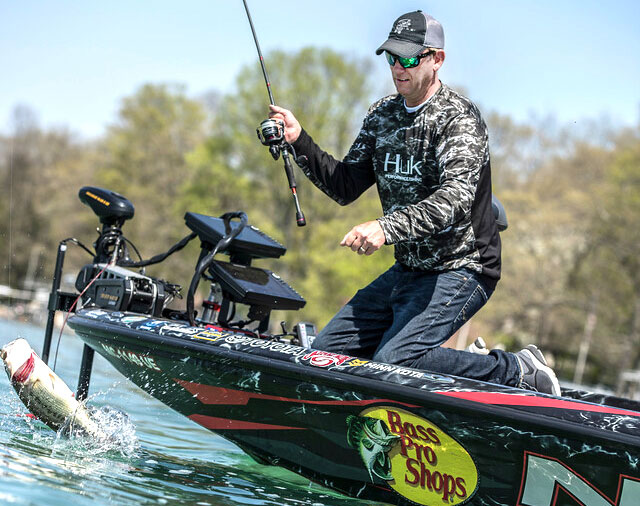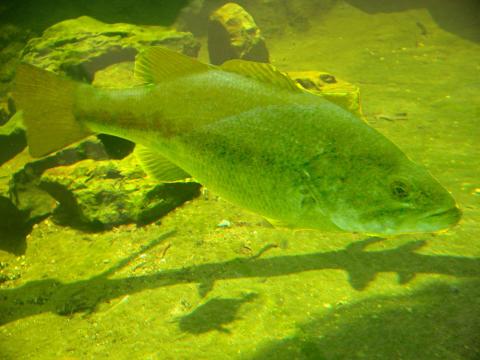provided by John E. Phillips
Mossy Oak Fishing Pro Kevin VanDam of Kalamazoo, Michigan, is the only professional fisherman to win four Bassmaster Classics and three Major League Fishing cups. Kevin’s one of the fastest fishermen finding and catching bass in every tournament he attends. He’s a very detailed angler and a keen observer of everything around him when he’s on the water. Sights and signals that most bass fishermen completely overlook are some of the keys to VanDam’s success. Mossy Oak wanted to know how VanDam finds and catches bass during a time of the year where many lakes will contain pre-spawn, spawning and post-spawn bass.
The spawn is a crazy time of the year because you’ll encounter some pre-spawn bass, some bass that are moving up to spawn that haven’t spawned yet, some spawning bass and some post-spawn bass. Not all the bass spawn at the same time. How do you decide what bass you’ll fish for, and what lures you’ll use?
VanDam: Mother Nature has planned to not let all the bass in any lake spawn at the same time. Some of the female bass always are spawning early. You’ll have a lot of bass spawn under optimal spawning conditions too. Yet there will be some bass that spawn late after all the other bass have left the spawning flats. Under those conditions, I’ll be searching for a group of pre-spawn bass that haven’t gone to the bed yet. If I can find a group like that, generally those bass will be feeding actively and will be bigger than the bass sitting on the bed.
When those pre-spawners are moving in to spawn, oftentimes the only way you can catch them is to make them mad. I fish a much slower-moving lure methodically then. Sometimes I may go after the post-spawn bass because they’ll be actively feeding, and they’re trying to eat as much as they can to bulk back up after the spawn. They’ll be moving just offshore and often be grouped up in large schools. You can be efficient catching those post-spawners in a short time.
If I reach the lake and see there’s a large number of bass in shallow water on the spawning flats spawning, then I may look for a channel or the first drop-off coming away from the flats to find a group of pre-spawn bass that haven’t gone to the flats yet. There’s no right or wrong answer as to which type of fish to try and catch. Some very good sight fishermen are on the Major League Fishing trail, and we have some really good midwater anglers who catch bass going to and from the spawning flats. We also have a group of anglers who prefer to go after the pre-spawn bass because they know if they can find them, those bass may be bigger than the bass going to the flats or away from the flats. Many times, the techniques that an angler likes to fish best determine which phase of the spawn he prefers to fish.
When you arrive at a lake, and you know pre-spawn, spawning and post-spawn bass are moving in-between the spawning flats going away or to the flats, how do you decide which bass to target and why?

VanDam: Almost every lake I fish is different. Here’s how I make that decision. I fish for whatever segment of that bass population is the easiest and fastest to catch. If I’m fishing a tournament, I look at the weather every morning and the long-term forecast. And here’s why. If I get to a lake, I know numbers of bass are spawning, we’re having a four-day tournament, and the weather warms up every day we’re fishing, then I’ll fish for the post-spawn bass because I know the bass that are spawning will spawn out in deeper water as the weather gets warmer. Sometimes though, just the opposite is true.
When I won the Bassmaster Classic in 2011 in New Orleans, the weather was really cold during the practice days. However, from the long-range forecast, I saw a warming trend that would move in toward the end of the week. I knew with that warm weather coming that the bass would start moving into the spawning flats. Even though the bass weren’t on the spawning flats during practice, I felt certain they would be on the spawning flats during competition days. We saw pre-spawn and spawning bass moving within three days – that’s how fast the bass could transition between the pre-spawn and the spawn. I always look at the weather to try and decide where the bass will be, depending on whether the region has a warm or a cold front or other weather conditions that will affect the bass on a competition day.
On the first day of competition, I went straight to the spawning flats with stumps on them, and those big spawners came to me. On the last day of practice, I only got two bites, but one of those fish was a 10-pounder. So I went back to that spawning flat on the first day of the tournament and caught bass slow-rolling a spinner bait. The bass were just sniffing around looking for a place to spawn.
On the second day of practice, those big females began to bump and sniff my bait, so I changed to a KVD 1.5 squarebill crankbait. I’d hit the stumps with a crankbait, and that would trigger those spawning bass to bite. On the third day, I’d have to make four or five casts to the same stump to get the bass to bite. By this third day with the water having warmed up, the bass were already starting to spawn. So, I knew I had to aggravate them and make them mad to get them to bite. The water was dirty that last day, and I couldn’t see the stumps. I had to fan cast, until my crankbait hit the stump. Once I’d identified where the stump was, I cast and cast until I felt the bass bite.
What does casting multiple times to the same target do to make the bass bite?
VanDam: When a female bass doesn’t want to bite, and you keep aggravating her with the same lure, I think she gets mad and wants to kill that bait by eating it. Anytime I’m getting short bites and/or the bass aren’t taking the baits deep in their mouths, that’s when I try to aggravate the bass to make them want to kill the bait. If that doesn’t work, then I fish a lure with a more- horizontal presentation like flipping or pitching a worm into that spot where the bass won’t take my bait. Also, I’ll leave the bait on the bottom longer than normal - perhaps 10-15 seconds before I move it. I believe that a bedding bass will look at the lure and just get madder and madder until she finally attacks. The other thing I’ll do when I let the lure lay on the bottom is I shake my rod tip to cause the lure to quiver or shake in that spot to give the appearance of a live critter, whether it’s a worm or a lizard, or whatever I’m fishing.






























